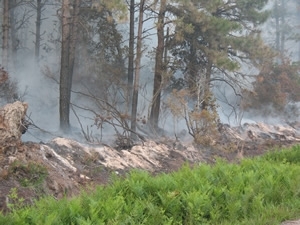Peat Wildfire Smoke and Heart Failure Risk
Study Finds Peat Wildfire Smoke
Linked to Heart Failure Risk
In the summer of 2008, a lightning strike started a wildfire in eastern North Carolina that burned for weeks, blanketing nearby communities in smoke. A U.S. Environmental Protection Agency (Environmental Protection Agency's Profile) (EPA) study shows for the first time that smoke from this wildfire, which was fueled by peat (decayed vegetable matter found in swampy areas) can lead to an increase in emergency room visits for both respiratory and cardiovascular effects.
This was the first study to report increased visits for symptoms of heart failure in counties exposed to wildfire smoke. The study found a 37 percent increase in emergency room visits for people with symptoms of heart failure during a three day period of dense smoke exposure and the following five days.
The EPA study also showed an increase in emergency department visits for problems relating to asthma, chronic obstructive pulmonary disease (COPD), pneumonia, and bronchitis, which are similar to studies of other wildfires.
Researchers used satellite imagery (Remote sensings functional role in studies of land-use/land-cover change) to identify counties impacted by the wildfire, and obtained numbers of emergency room visits for cardiac and respiratory problems in exposed and nearby unexposed counties to show the health impact of this fire.
This was not a unique occurrence. Each year NC experiences more than 100 wildfires and the summer of 2011 has resulted in a peat bog wildfire, which has already consumed 45,000 acres, impacting coastal and inland counties continuously since May 5.
The study findings are expected to provide relevant and important information for state and county public health officials as they consider strategies to address the adverse health effects of wildfire smoke in the general public and especially in vulnerable populations.
The study did not examine health effects from other fires such as controlled fires that are intentionally set or other fires that burn vegetation, but not peat. The findings cannot be extrapolated to non-peat related fires. Peat fires tend to burn slowly and close to the ground so that the smoke is not as easily moved upward into the atmosphere. They are also very difficult to extinguish and can last for weeks or months.
The study was published online June 27 in Environmental Health Perspectives in collaboration with researchers from the University of North Carolina at Chapel Hill, The Brody School of Medicine at East Carolina University, Pitt County Memorial Hospital and the NC Division of Public Health. The title is: Peat Bog Wildfire Smoke Exposure in Rural North Carolina is Associated with Cardiopulmonary Emergency Department Visits Assessed Through Syndromic Surveillance.
June 27, 2011
For more information on air quality conditions in your state, visit: http://www.airnow.gov/
